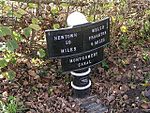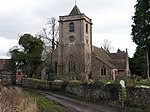Knockin Castle
Castles in ShropshireEngland castle stubsShropshire building and structure stubs
Knockin Castle is situated in the village of Knockin on Shropshire between Oswestry and Shrewsbury (grid reference SJ334223), England. This was a motte-and-bailey castle founded by Guy le Strange between 1154 and 1160 and it remained the principal holding of the le Strange family for most of the Middle Ages. The castle was damaged in the First Barons' War during the reign of King John and then repaired by John le Strange. It was described as being 'ruinous' in 1540. All that remains of Knockin Castle today is a large tree-covered mound of earth.
Excerpt from the Wikipedia article Knockin Castle (License: CC BY-SA 3.0, Authors).Knockin Castle
The Avenue,
Geographical coordinates (GPS) Address Nearby Places Show on map
Geographical coordinates (GPS)
| Latitude | Longitude |
|---|---|
| N 52.79414 ° | E -2.98913 ° |
Address
The Avenue
SY10 8HJ
England, United Kingdom
Open on Google Maps






